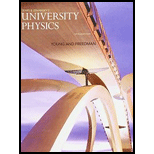
In Fig. 30.11, suppose that ε = 60.0 V, R = 240 Ω, and L = 0.160 H. With switch S2 open, switch S1, is left closed until a constant current is established. Then S2 is closed and S1 opened, taking the battery out of the circuit. (a) What is the initial current in the resistor, just after S2 is closed and S1 is opened? (b) What is the current in the resistor at t = 4.00 × 10−4 s? (c) What is the potential difference between points b and c at t = 4.00 × 10−4 s? Which point is at a higher potential? (d) How long does it take the current to decrease to half its initial value?
Want to see the full answer?
Check out a sample textbook solution
Chapter 30 Solutions
University Physics (14th Edition)
Additional Science Textbook Solutions
Chemistry: Structure and Properties (2nd Edition)
Applications and Investigations in Earth Science (9th Edition)
Chemistry (7th Edition)
Microbiology: An Introduction
Microbiology: An Introduction
Anatomy & Physiology (6th Edition)
- Solve and answer the question correctly please. Thank you!!arrow_forwardA spiral transition curve is used on railroads to connect a straight portion of the track with a curved portion. (Figure 1) Part A v = v₁ft/s 600 ft y = (106) x³ If the spiral is defined by the equation y = (106)³, where x and y are in feet, determine the magnitude of the acceleration of a train engine moving with a constant speed of v₁ = 30 ft/s when it is at point x = 600 ft. Express your answer to three significant figures and include the appropriate units. ? a = Value Unitsarrow_forwardsolve and answer the problem correctly please. Thank you!!arrow_forward
- Solve and answer the question correctly please. Thank you!!arrow_forwardSolve and answer the question correctly please. Thank you!!arrow_forwardWhen the motorcyclist is at A, he increases his speed along the vertical circular path at the rate of = (0.3t) ft/s², where t is in seconds. Take p = 360 ft. (Figure 1) Part A 60° Ρ B If he starts from rest at A, determine the magnitude of his velocity when he reaches B. Express your answer to three significant figures and include the appropriate units. v = Value Submit Request Answer ་ Part B ? Units If he starts from rest at A, determine the magnitude of his acceleration when he reaches B. Express your answer to three significant figures and include the appropriate units. 11 ? a = Value Unitsarrow_forward
- The car starts from rest at s = 0 and increases its speed at a₁ = 7 m/s². (Figure 1) Part A = 40 m Determine the time when the magnitude of acceleration becomes 20 m/s². Express your answer to three significant figures and include the appropriate units. ? t = Value Units Part B At what position s does this occur? Express your answer to three significant figures and include the appropriate units. s = Value Submit Request Answer ? Unitsarrow_forwardSolve and answer the question correctly please. Thank you!!arrow_forwardSolve and answer the question correctly please. Thank you!!arrow_forward
- Solve and answer the question correctly please. Thank you!!arrow_forwardSolve and answer the question correctly please. Thank you!!arrow_forwardr 2. Measuring Length mm 1 cm 2 3 INCH 1 16THS 5 6 7 8 9 10 11 FAIRGATE COLD SPRING, NEW YORK 2 3 12 1. Using the metric (top) scale only, what units are being used for the long lines with the numbers? Hint: Remember that 2.54 cm = 1 in. 2. What are the units of the small lines? 3. How many decimal places should be recorded using this tool? 4. What is the length of the red line? Note: Make sure to use the correct units and decimal places. 5. Now observe your ruler. What metric units are used on your ruler? 6. How many decimal places should you record when using your ruler? 7. Measure a box, book, coin and can and fill out the data table below. Make sure to use units and the correct number of decimal places for your ruler. Table 1: Measuring Length Data Table Object Length of the box Length Local PR Distribution Only $99/Release. Get Started On Our Website Now! V 2 217arrow_forward
 College PhysicsPhysicsISBN:9781285737027Author:Raymond A. Serway, Chris VuillePublisher:Cengage Learning
College PhysicsPhysicsISBN:9781285737027Author:Raymond A. Serway, Chris VuillePublisher:Cengage Learning
 Physics for Scientists and Engineers: Foundations...PhysicsISBN:9781133939146Author:Katz, Debora M.Publisher:Cengage Learning
Physics for Scientists and Engineers: Foundations...PhysicsISBN:9781133939146Author:Katz, Debora M.Publisher:Cengage Learning Principles of Physics: A Calculus-Based TextPhysicsISBN:9781133104261Author:Raymond A. Serway, John W. JewettPublisher:Cengage Learning
Principles of Physics: A Calculus-Based TextPhysicsISBN:9781133104261Author:Raymond A. Serway, John W. JewettPublisher:Cengage Learning College PhysicsPhysicsISBN:9781305952300Author:Raymond A. Serway, Chris VuillePublisher:Cengage Learning
College PhysicsPhysicsISBN:9781305952300Author:Raymond A. Serway, Chris VuillePublisher:Cengage Learning College PhysicsPhysicsISBN:9781938168000Author:Paul Peter Urone, Roger HinrichsPublisher:OpenStax College
College PhysicsPhysicsISBN:9781938168000Author:Paul Peter Urone, Roger HinrichsPublisher:OpenStax College





